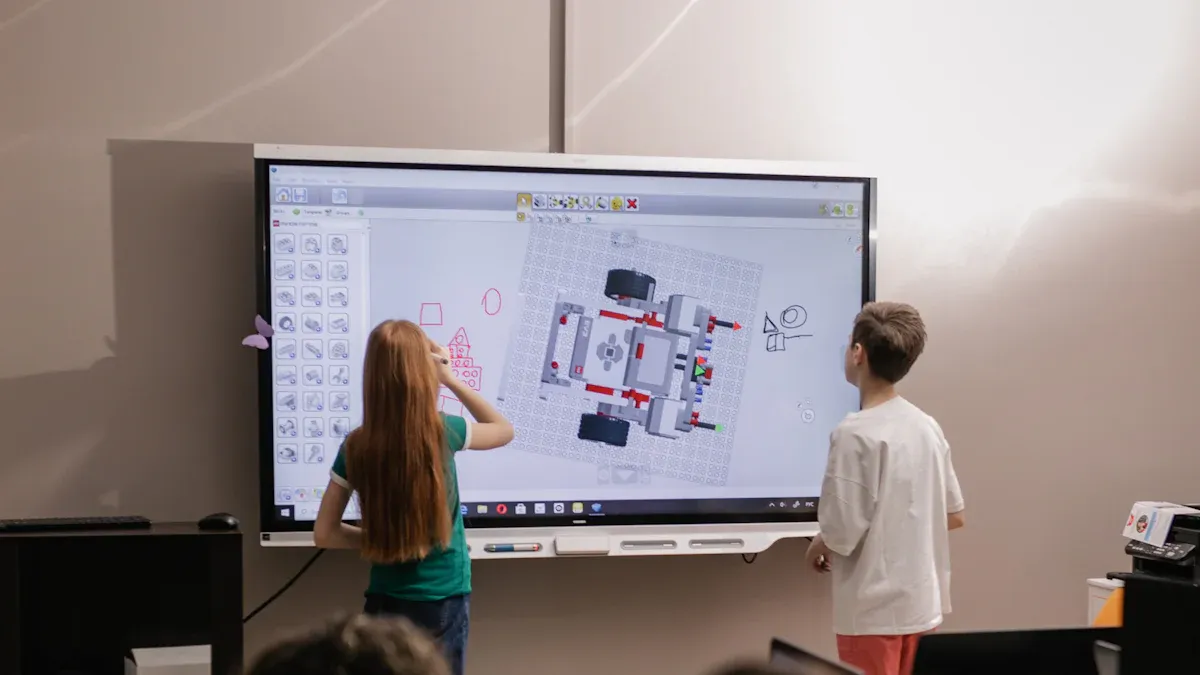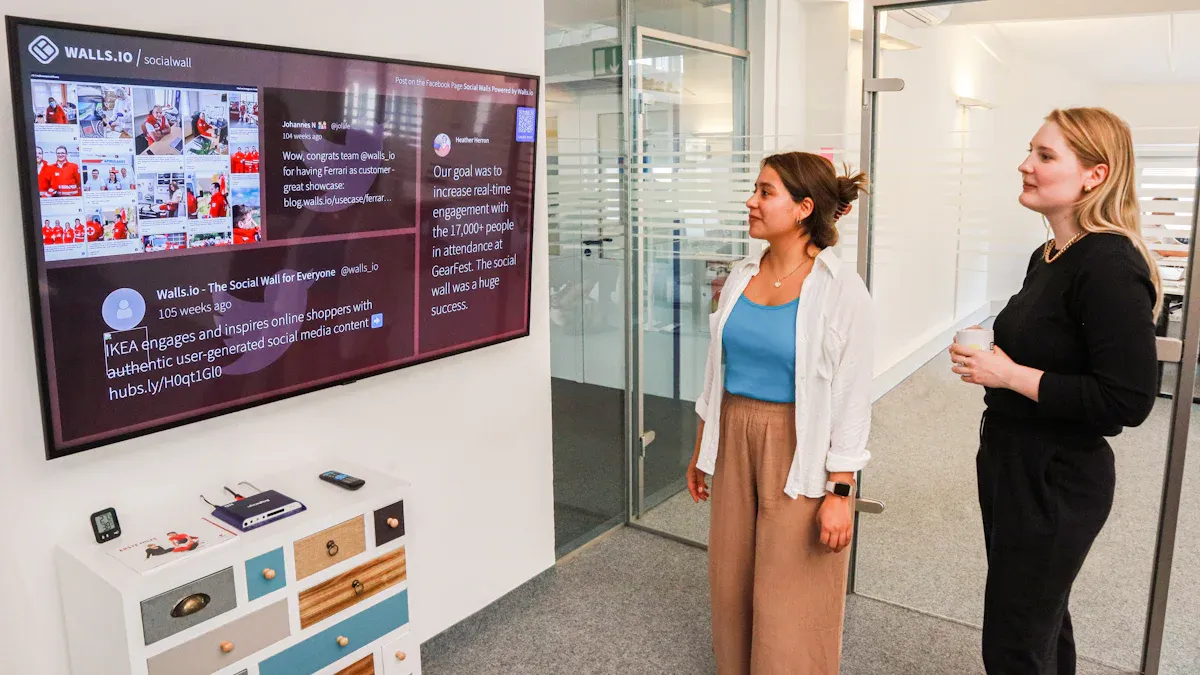How to Select the Right Smart Board for Your Business in 2025

The best smart board for your business will align with your collaboration goals, work smoothly with your existing systems, and fit your budget. In 2025, upgrading to business smart boards becomes vital as the market grows rapidly, fueled by AI-driven features and the demand for interactive tools:
The global smart board market was valued at USD 5.58 billion in 2024.
Experts project it will reach USD 9.54 billion by 2033.
Specification Type | Details |
|---|---|
Minimum Onboard Storage | 64GB |
Recommended Onboard Storage | 128GB or more |
Storage Type | SSD preferred over traditional HDD |
Cloud Storage Integration | Essential for seamless access |
You need a step-by-step approach to match smart board features with your office setup and team needs.
Key Takeaways
Identify your team's specific needs before choosing a smart board. Consider how your team will use it, whether for video conferencing, brainstorming, or presentations.
Select a smart board that fits your office size and layout. Smaller rooms may need 55" displays, while larger spaces benefit from 75" or bigger screens.
Ensure compatibility with existing technology. Choose a smart board that supports your preferred operating systems and software tools for seamless integration.
Focus on user experience. Look for boards with responsive touch technology and intuitive interfaces to enhance collaboration and reduce training time.
Consider the total cost of ownership. Factor in installation, software licensing, and maintenance to find a smart board that offers long-term value.
What Are Business Smart Boards
Smart Board Functions
Business smart boards serve as advanced interactive whiteboards designed for modern workplaces. You can use them to boost collaboration and streamline business meetings. These devices combine touch-sensitive displays with built-in software, allowing you to brainstorm, present, and annotate in real time. The best smart board for your team will offer a unified interface that supports both in-person and remote teamwork.
Function | Description |
|---|---|
Collaboration | Smart boards provide a unified interface for brainstorming and data presentation, facilitating teamwork both in-person and remotely. |
Engagement | They allow participants to interact by tapping, writing, and annotating in real-time, enhancing information retention and participation. |
Integration | Smart boards support various software tools like Zoom and Microsoft Teams, making remote collaboration seamless. |
Content Saving | Most smart boards can save content directly to the cloud or team folders, improving post-meeting productivity. |
Remote Collaboration | With built-in microphones and cameras, smart boards enhance remote meetings, making participants feel as if they are in the same room. |
You will find that business smart boards often include multi-touch functionality. This feature lets several users interact with the board at once, which is ideal for group brainstorming. Features like palm rejection and pressure-sensitive stylus input create a natural writing experience.
Benefits for Office Use
When you use a smart board for office use, you create a shared workspace that connects your team, whether they work in the office or remotely. These boards make it easy to communicate and share ideas in real time. You can capture, save, and share notes instantly, so everyone stays on the same page after business meetings.
Real-time communication and idea sharing help teams work together, even in hybrid settings.
Interactive whiteboards allow for dynamic presentations with live annotations and instant feedback.
Training sessions become more engaging with features like quizzes and live annotation.
Cloud integration ensures that notes and files are saved automatically, making it easy to access materials later.
Touch sensitivity and multi-user support encourage group collaboration and creativity.
Business smart boards improve productivity by making meetings more interactive and efficient. You can rely on these tools to support your team’s workflow and keep everyone engaged.
How to Choose the Best Smart Board
Use Cases and Team Size
Start by identifying how your team will use the smart board. Different businesses have unique needs. Some teams focus on video conferencing, while others rely on collaborative brainstorming or client presentations. You may even need a combination of these activities. The best smart board for your business should support your most common tasks.
Use Case | Description |
|---|---|
Seamless integration with Microsoft 365 applications enhances productivity for businesses. | |
Video Conferencing | Smart boards support video conferencing, facilitating remote communication and collaboration. |
Collaborative Brainstorming | They enable teams to brainstorm and collaborate in real-time, improving creativity and engagement. |
Client Presentations | Smart boards can be used for impactful client presentations, enhancing visual communication. |
Think about your team size. Small groups may only need a single interactive whiteboard, while larger teams benefit from multiple boards or larger displays. If your team often works together in business meetings, choose a smart board that allows several users to interact at once. This feature supports digital brainstorming and keeps everyone engaged.
Office Size and Layout
The size and layout of your office play a big role in choosing the best smart board. A screen that is too small can frustrate viewers, while one that is too large can overpower the space. For smaller conference rooms or individual offices, a 55"–65" display works well. Larger boardrooms or training areas usually require a 75" or bigger panel for clear visibility.
Factor | Consideration |
|---|---|
Smaller rooms may use 55-inch displays; larger rooms may need 75-inch or larger panels for visibility. | |
Mounting Options | Wall mounting is space-efficient; mobile stands offer flexibility; height-adjustable options improve accessibility. |
You also need to decide between wall-mounted and mobile smart boards. Wall-mounted options save space and provide a permanent installation, which is ideal for small offices. Mobile smart boards offer flexibility. You can move them between rooms and adjust viewing angles as needed.
Feature | Mobile Smart Board | |
|---|---|---|
Flexibility | Fixed in place | Highly flexible, can be moved easily |
Portability | Not portable | Often includes wheels for easy movement |
Space Efficiency | Saves wall space | Requires floor space, but can be repositioned |
Ideal Use Case | Small spaces | Various layouts and room changes |
Tip: Choose a mobile interactive display if your team often changes meeting locations or needs to share the board across departments.
Compatibility and Connectivity
Check the compatibility of the smart board with your existing office technology. Most business smart boards in 2025 support Android, ChromeOS, and Windows. Each system offers unique advantages. Android provides access to the Google Play Store and a user-friendly interface. ChromeOS boots quickly and integrates well with Google Workspace. Windows supports Microsoft software and enterprise systems.
Operating System | Features and Advantages |
|---|---|
Android | Access to Google Play Store, user-friendly interface, dual OS capabilities for Windows applications. |
ChromeOS | Quick boot, automatic updates, integration with Google Workspace, superior security. |
Windows | Compatibility with Microsoft software, support for enterprise systems, upgradeable hardware. |
Connectivity options are also important. The best smart board for office use should offer wireless connectivity, device compatibility, and universal ports. These features allow everyone to connect, no matter what device they use.
Connectivity Option | Description |
|---|---|
Wireless Connectivity | Essential for a seamless user experience, allowing users to connect without cables. |
Device Compatibility | Supports a wide range of devices, ensuring all participants can connect regardless of device. |
Cross-Platform Integration | Ensures compatibility with various operating systems and collaboration software. |
Universal Ports and Adapters | Allows connection of devices that do not support wireless connectivity. |
User Experience
User experience should guide your decision when choosing the best smart board. Look for interactive whiteboards with responsive touch technology and intuitive interfaces. Hardware specifications matter for performance and durability. Software capabilities determine what you can do during business meetings, from sharing files to running apps.
Feature | Description |
|---|---|
Hardware Specifications | Essential for performance and durability in business settings. |
Touch Technology | Impacts the responsiveness and ease of use for users. |
Connectivity Options | Ensures compatibility with existing tools and platforms, enhancing collaboration. |
Operating Systems | Affects the software compatibility and user familiarity. |
Software Capabilities | Determines the range of functionalities available for business applications and productivity. |
Note: A smart board with a simple, intuitive interface reduces the need for training and helps your team adopt the technology faster.
You should also consider the total cost of ownership. This includes installation, software licensing, support, and maintenance. For example, installation costs range from $200 to $1,500. Annual software licensing and support can cost $100 to $500, while maintenance and repairs may add $100 to $300 each year. Plug-and-play smart boards often have lower long-term costs compared to traditional systems because they bundle services and reduce maintenance needs.
Cost Component | Estimated Cost Range |
|---|---|
Installation Costs | $200 to $1,500 |
Software Licensing & Support | $100 to $500 annually |
Maintenance & Repair Costs | $100 to $300 annually |
Equipment Type | Initial Costs | Long-term Costs | Total Cost of Ownership (5 years) |
|---|---|---|---|
High | Higher due to multiple components and maintenance | Higher due to fragmented systems | |
Plug-and-Play Smart Classroom Equipment | Moderate | Lower due to integrated system and reduced maintenance | Lower due to bundled services |
Choosing the best smart board means balancing features, compatibility, user experience, and cost. When you match the smart board to your business needs, you create a more productive and engaging environment for your team.
Smart Board for Office Use: Features to Compare

Screen Size and Technology
When you compare interactive whiteboards, screen size stands out as one of the most important features to look for in a smart board. The right size ensures everyone can see and interact with the content during business meetings. In 2025, the most popular sizes for business use range from 50 inches to 86 inches. Larger displays, like 75" and 86", are especially popular for bigger conference rooms.
Screen Size | Popularity |
|---|---|
50" | Common |
55" | Common |
65" | Common |
75" | Very Popular |
86" | Very Popular |
Touch technology also makes a big difference in user experience. Leading models like the SMART Board RX Series and BenQ Board Pro offer up to 40 simultaneous touch points. This means several people can write, draw, or move objects at the same time. Features like pressure-sensitive ink and palm rejection create a natural writing feel, making your interactive display easy to use for everyone.
Software and Integration
You should always check how well a smart board integrates with your favorite software platforms. Many smart boards for office use now support ChromeOS, Google Workspace, and Microsoft 365. These platforms let you run video calls, edit documents, and share files directly from the board.
Software Platform | Integration Features |
|---|---|
ChromeOS | Works with Google Meet, Drive, and other Google apps; strong security. |
Google Workspace | Lets you edit Docs, Sheets, and Slides together on the board. |
Microsoft 365 | Supports Teams Rooms, OneDrive, SharePoint, and Microsoft Whiteboard. |
This level of integration helps you run smooth business meetings and makes it easy to switch between different tools.
Durability and Value
Durability matters when you invest in a smart board for office use. Look for models with tough glass, sturdy frames, and long warranties. These features protect your investment and reduce repair costs. You should also think about long-term value. Choose a smart board that supports software updates and new features. This future-proofs your purchase and keeps your technology up to date.
Tip: Compare top models available in 2025 for both hardware quality and software support. A reliable smart board will serve your team well for years and adapt to new business needs.
Implementation Tips

Setup and Integration
You can set up your smart board quickly if you follow a clear plan. Start by choosing the right location in your office. Make sure everyone can see the screen during business meetings. Check that you have enough power outlets and a strong Wi-Fi signal in the room.
Most smart boards come with step-by-step guides. Use these instructions to mount the board on the wall or place it on a mobile stand. Connect the board to your network and test the internet connection. Plug in all necessary cables, such as HDMI or USB, to link the board with your computers and other devices.
Tip: Test the smart board with your main collaboration tools, like video conferencing apps or shared drives, before your first meeting. This helps you avoid technical issues.
You should also update the board’s software. Updates often add new features and improve security. Schedule regular checks to keep your smart board running smoothly.
Training and Adoption
Training helps your team use the smart board with confidence. Start with a short demo that covers basic features, such as writing, erasing, and sharing content. Show how to join video calls and save notes during business meetings.
Create a simple guide or checklist for daily use. Encourage your team to practice with the board. You can set up short training sessions or ask team members to share tips they discover.
Training Step | Purpose |
|---|---|
Basic Demo | Introduce main features |
Practice Sessions | Build user confidence |
Troubleshooting Tips | Solve common problems quickly |
Note: Regular feedback from your team helps you spot issues early and improve adoption. Celebrate small wins as your team gets more comfortable with the technology.
Choosing the right smart board means you match features to your business needs, check compatibility, and consider total cost of ownership. You gain long-term benefits like enhanced collaboration, increased engagement, and improved productivity.
Benefit | Description |
|---|---|
Enhanced Collaboration | Teams work together more effectively in real time. |
Future Adaptability | Smart boards prepare you for new work styles and hybrid models. |
Take a systematic approach. Consult with your team before you invest. As technology advances with AI and IoT, you secure your business’s growth by selecting a solution that adapts to future trends and keeps your team competitive.
FAQ
What is the difference between smart whiteboards for business and regular whiteboards?
Smart whiteboards for business let you interact with digital content, save notes, and connect with devices. Regular whiteboards only allow you to write and erase manually. Smart boards improve teamwork and make meetings more productive.
Can you use smart boards with your existing business tools?
You can connect smart boards to most business tools, including video conferencing apps and cloud storage. This helps you share files, run meetings, and work with your team more easily.
How do you keep your smart board secure?
You should update software regularly and use strong passwords. Many smart boards offer user authentication and data encryption. These steps protect your information and keep your meetings safe.
What size smart board works best for a small office?
A 55-inch smart board fits most small offices. It gives everyone a clear view and saves space. You can choose a wall-mounted or mobile option based on your room layout.
Do you need special training to use a smart board?
Most smart boards have easy-to-use interfaces. You can learn basic features quickly with a short demo. Practice helps your team get comfortable and use the board effectively.
See Also
Maximizing the Impact of Smart Boards in Today's Classrooms
Understanding Smart Boards: Functionality and Benefits Explained
Selecting the Right Video Wall: LED vs. LCD Explained
Enhancing Meeting Efficiency with Smart Office Screens from BOE
Best Digital Signage Solutions for Effective Business Communication